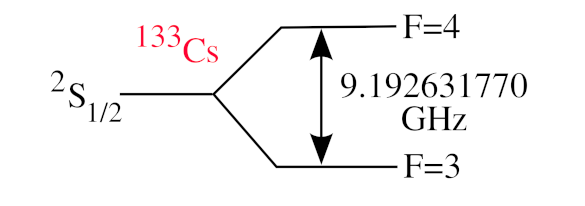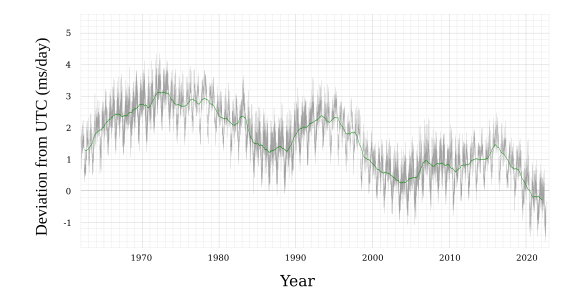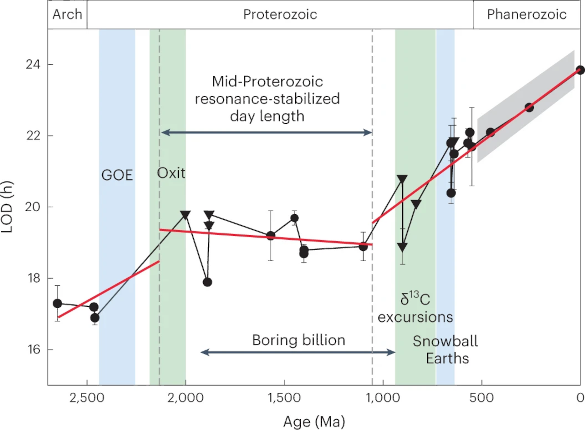Length of a Day
July 24, 2023
Businesses advertise their availability as 24
hours a
day, 7 days a
week, and 365 days a
year (
24/7/365), I always thought it strange that they all decided to take
leap year day as a
holiday. Since the length of
time between one
vernal equinox or
autumnal equinox to another is 365 days, 5 hours, 48
minutes, and 46
seconds (365.2422 days), we need to add a day every four years to more closely track the
seasons over time in our
Gregorian calendar. This 0.25 day correction is a little too much, so years exactly
divisible by 100 are leap years only if they are exactly divisible by 400; so, the
year 2000 was a leap year.
The passage of time is presently measured by
atomic clocks with the
precision of more than one
part in 10
14, for an precision of about one
second in a billion years. I wrote about a
ytterbium atomic clock in an
earlier article (Ytterbium Atomic Clock, March 16, 2012). The second has been
defined since 1967 as 9,192,631,770
ticks of the unperturbed
ground state hyperfine transition of
cesium-133. The
frequency of this transition is easily accessed by our present
radio frequency technology by which nearly everyone has a
gigahertz transmitter and
receiver in their
5G cellphones.

The atomic clock electron transition in cesium-133. (Created using Inkscape)
Earth's rotational rate is slightly variable, and it slows enough for a
leap second to be added as required. Since the leap second was introduced in 1972, there have been 27 leap seconds added to the
Coordinated Universal Time (UTC). Whether a leap second is added at year's end, or not, is decided about six months prior by the
International Earth Rotation and Reference Systems Service (IERS). Leap seconds can't be planned farther in advance than that, since the Earth's short term rotation rate is
unpredictable.
Why would Earth's rotational rate change at all? The main factor is the
tidal friction of the
oceans caused by the
Sun and
Moon. This lengthens the day by 2.3
milliseconds per
century.
Earth's core being
liquid with variable
convective flows causes short-term variation. Large
crustal events change the distribution of
mass, and thereby Earth's
moment of inertia. The
Indian Ocean earthquake of 2004 apparently shortened the day by 2.68
microseconds.
A
mathematical model of the length of the
solar day was created in 2004 based on
eclipse records from 700
BC -1623
AD, other
telescopic observations from 1623-1967, and atomic clocks from 1968-1990.[1] The model revealed a long-term increase of the mean solar day by 1.70 ms per century and a
periodic shift of about 4 ms in
amplitude with a
period of about 1,500 years.[1]

Deviation of day length from the day derived from the SI second for the period 1962-2022. The annual variation is apparent, as well as the unpredictable short-term and long-term variations in these data from the International Earth Rotation and Reference Systems Service (IER). (Modified Wikimedia Commons image. Click for larger image.)
Crossing
time zones and the changes back and forth between
standard time and
daylight saving time have always been an
annoyance. However, the advent of the
Internet created problems that focused on the seconds level of time. Such problems include accurate
timestamping of
communications and
process control systems, especially interactions between
computers that adjust for leap seconds, and those that don't. On my
Linux desktop computer, leap seconds are handled by repeating 23:59:59. That's because the useful timestamp,
Unix time, wants a day to be exactly 86,400 seconds. There's a movement afoot to abandon the leap second as a simplification (and let our
progeny deal with any consequences, as for the
year 2000 problem).
The
length of a day is presently increasing. Does this mean that Earth's day was much shorter in the
distant past? An international team of
geoscientists from the
Chinese Academy of Sciences (Beijing, China), the
University of Tübingen (Tübingen, Germany), and
Curtin University (Perth, Australia) found that the day length in the
Mid-Proterozoic was just 19 hours.[2-3] More interestingly, this 19 hour day persisted for a billion years.[2-3] This persistence of day length at 19 hours coincides with a period of relatively limited
biological evolution that's known as the
boring billion.[2-3]
It's generally accepted that Earth's rotation was more rapid in the past as it is now, leading to a shorter day.[3] That's because the
Moon's orbit was closer to Earth. Since the Earth rotates faster than the
orbital angular velocity of the Moon, the
oceanic tidal bulge of Earth is pushed ahead of the Moon. This exerts a
torque on the Moon and boosts the Moon to a farther orbit.[2] However, by
angular momentum conservation, Earth's rotation slowed as the Moon's orbital
radius increased.[3] A
geological record of day length is preserved in some
sedimentary rocks created by fine-scale
layering in
tidal mudflats.[3] The number of layers relates to tidal fluctuations, but such an
analysis is difficult.[3]
A better approach, called
cyclostratigraphy, is to examine a different type of sedimentary layering affected by
astronomical events called
Milankovitch cycles reflecting
climate variations caused by changes in Earth's orbit and rotation.[3] Says
Uwe Kirscher, a study
author and a
research fellow in the
School of Earth and Planetary Sciences of Curtin University,
"Two Milankovitch cycles, axial precession of the Earth and obliquity, are related to the wobble and tilt of Earth's rotation axis in space. The faster rotation of early Earth can therefore be detected in shorter precession and obliquity cycles in the past."[3]

Milankovitch cycles captured in 600-million-year-old sedimentary rock.
Analysis of such sediments allows an estimate of the length of day in Earth's distant past.
(Chinese Academy of Sciences image by Ross Mitchell. Click for larger image.)
Kirscher and fellow author,
Ross Mitchell, an
associate professor in the
Institute of Geology and Geophysics Chinese Academy of Sciences (IGGCAS), were encouraged to do their study after a dramatic increase in Milankovitch geological data in the past seven years, especially for the
Precambrian, a
geological period extending from 4.6 billion to about 538.8 million years ago.[3] Such data allow length of day estimation at a time when other biological means, such as
tree rings and
coral growth bands, are not possible.[2]
Their
statistical analysis of the Precambrian data for the length of day showed that it stalled at about 19 hours for about 1 billion years during in the middle of the
Proterozoic.[2] The Proterozoic is the
geological eon extending from 2500 to 538.8 million years ago.[2] It's
theorized that
atmospheric thermal tides from
solar energy, which cause an accelerative torque, were balanced by the decelerative torque of
lunar oceanic tides, and this stabilized Earth's rotation.[2] Says Kirscher,
"Because of this, if in the past these two opposite forces were to have become been equal to each other, such a tidal resonance would have caused Earth's day length to stop changing and to have remained constant for some time."[3]
This stalling of day length ends with a large rise in atmospheric
oxygen. This indicates that longer days were needed for
photosynthetic bacteria to generate more oxygen.[3]

Summary of the length of day data from Extended Data Table 1 of ref. 2, including error bars when possible.[4] (Fig. 2 of ref. 2, released under a Creative Commons Attribution 4.0 International License.[2] Click for larger image.)
References:
- L. V. Morrison and F. R. Stephenson, "Historical Values of the Earth's Clock Error Δ and the Calculation of Eclipses," Journal for the History of Astronomy, vol. 35, part 3, no. 120 (2004), pp. 327-336, https://doi.org/10.1177/002182860403500. The article is unfortunately paywalled, but images of all pages are available at the SAO/NASA Astrophysics Data System (ADS).
- Ross N. Mitchell and Uwe Kirscher, "Mid-Proterozoic day length stalled by tidal resonance," Nature Geoscience, June 12, 2023, DOI: 10.1038/s41561-023-01202-6. This is an open access article with a PDF file at the same URL
- 19-hour days for a billion years of Earth's history: Study, Chinese Academy of Sciences Press Release, June 12, 2023.
- Supplementary materials for ref. 2.
Linked Keywords: Business; advertising; advertise; hour; day; week; year; 24/7 service; 24/7/365; leap year day; holiday; time; March equinox; vernal equinox; September equinox; autumnal equinox; minute; second; season; Gregorian calendar; division (mathematics); divisible; year 2000; atomic clock; precision; parts-per notation; part; ytterbium; International System of Units; define; ground state; hyperfine structure; hyperfine transition; cesium-133; frequency; radio frequency; technology; hertz; gigahertz; transmitter; receiver (radio); 5G; mobile phone; cellphone; electron transition; Inkscape; Earth's rotational rate; leap second; Coordinated Universal Time (UTC); International Earth Rotation and Reference Systems Service (IERS); extrapolation; unpredictable; tide; tidal; friction; ocean; Sun; Moon; millisecond; century; outer core; Earth's core; liquid; convection; convective; fluid dynamics; flow; crust (geology); mass; moment of inertia; Indian Ocean earthquake of 2004; microsecond; mathematical model; solar day; solar eclipse; Anno Domini; BC; AD; optical telescope; telescopic observation; periodic function; amplitude; period; Deviation of day length from the SI day, 1962-2022; deviation (statistics); day length fluctuation; day length; annual; data; time zone; standard time; daylight saving time; annoyance; Internet; timestamp; timestamping; communication; process control system; computer; Linux; desktop computer; Unix time; offspring; progeny; year 2000 problem; deep time; distant past; Earth science; geoscientist; Chinese Academy of Sciences (Beijing, China); University of Tübingen (Tübingen, Germany); Curtin University (Perth, Australia); Mid-Proterozoic; biological evolution; orbit of the Moon; Moon's orbit; orbital angular velocity; oceanic; tidal force; tidal bulge; torque; conservation of angular momentum; angular momentum conservation; radius; geology; geological; sedimentary rock; coating; layering; mudflat; tidal mudflat; analysis; cyclostratigraphy; astronomy; astronomical; Milankovitch cycles; climate; Uwe Kirscher; author; research; fellow; School of Earth and Planetary Sciences of Curtin University; axial precession of the Earth; axial tilt; obliquity; wobble; tilt of Earth's rotation axis in space; Milankovitch cycles captured in 600-million-year-old sedimentary rock; approximation; estimate; Ross Mitchell; associate professor; Institute of Geology and Geophysics Chinese Academy of Sciences (IGGCAS); Precambrian<; geologic time scale; geological period; dendrochronology; tree ring; coral; statistics; statistical; Eon (geology); geological eon; theory; theorized; atmosphere of Earth; atmospheric; insolation; solar energy; Moon; lunar; resonance; constant (mathematics); oxygen; photosynthesis; photosynthetic; bacteria; summary of the length of day data; error bar; Creative Commons Attribution 4.0 International License.